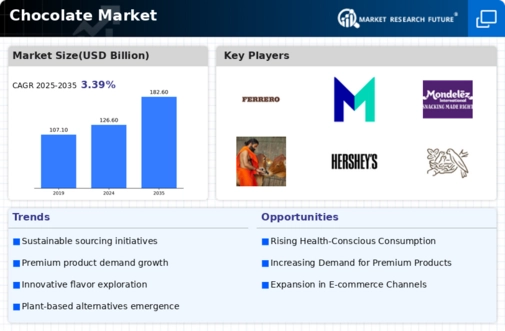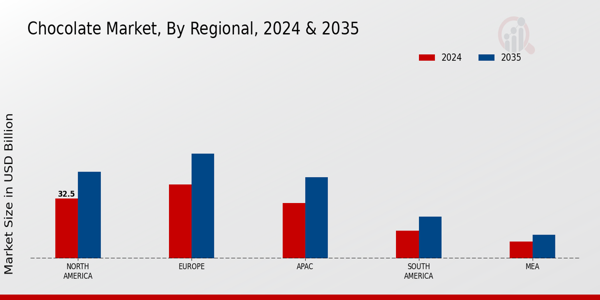Market Growth Projections
The Global Chocolate Industry is poised for substantial growth, with projections indicating a market value of 126.6 USD Billion in 2024 and an anticipated increase to 182.6 USD Billion by 2035. This growth trajectory suggests a robust demand for chocolate products across various segments, driven by evolving consumer preferences and market dynamics. The industry is expected to experience a compound annual growth rate (CAGR) of 3.39% from 2025 to 2035, reflecting a steady expansion in both traditional and innovative chocolate offerings. These projections underscore the resilience and adaptability of the chocolate market in meeting consumer demands.
Rising Demand for Premium Chocolate
The Global Chocolate Industry experiences a notable increase in demand for premium chocolate products. Consumers are increasingly seeking high-quality, artisanal chocolates that offer unique flavors and ingredients. This trend is driven by a growing awareness of health benefits associated with dark chocolate, which is rich in antioxidants. As a result, the market for premium chocolate is projected to expand significantly, contributing to the overall market value, which is expected to reach 126.6 USD Billion in 2024. This shift towards premium offerings indicates a potential growth trajectory for manufacturers who can innovate and cater to evolving consumer preferences.
Sustainability and Ethical Sourcing
Sustainability has become a pivotal driver in the Global Chocolate Industry, as consumers increasingly prioritize ethically sourced products. The demand for sustainable chocolate, which is produced with environmentally friendly practices and fair labor conditions, is on the rise. Companies that adopt sustainable sourcing practices not only enhance their brand reputation but also attract a growing segment of socially conscious consumers. This trend is likely to influence purchasing decisions, as consumers seek transparency regarding the origins of their chocolate. As sustainability becomes a core value for brands, it may significantly impact market dynamics and contribute to the industry's long-term growth.
E-commerce Growth and Digital Transformation
The Global Chocolate Industry is experiencing a significant transformation due to the rise of e-commerce platforms. Online retailing provides consumers with greater access to a diverse range of chocolate products, including niche and artisanal brands that may not be available in traditional retail outlets. This shift towards digital shopping is likely to enhance consumer convenience and broaden market reach for manufacturers. As e-commerce continues to expand, it is expected to play a crucial role in driving sales growth within the chocolate sector. This trend may contribute to the overall market growth, with a projected CAGR of 3.39% from 2025 to 2035.
Health Consciousness and Functional Chocolates
The Global Chocolate Industry is witnessing a shift towards health-conscious consumption patterns. Consumers are increasingly opting for chocolates that incorporate functional ingredients, such as superfoods, protein, and reduced sugar content. This trend aligns with a broader movement towards healthier lifestyles, where indulgence is balanced with nutritional benefits. The introduction of functional chocolates not only appeals to health-conscious consumers but also expands market opportunities for manufacturers. As the market evolves, it is anticipated that the demand for these innovative products will contribute to the industry's growth, potentially influencing the projected market value of 182.6 USD Billion by 2035.
Innovative Flavor Profiles and Product Diversification
The Global Chocolate Industry is characterized by a continuous evolution of flavor profiles and product diversification. Manufacturers are increasingly experimenting with unique ingredients, such as exotic spices, fruits, and herbs, to create innovative chocolate offerings. This trend caters to adventurous consumers who seek novel taste experiences. Additionally, the introduction of limited-edition flavors and seasonal products enhances consumer engagement and drives impulse purchases. As the market adapts to changing consumer preferences, the potential for growth in this segment appears promising, suggesting that innovation will remain a key driver in shaping the future of the chocolate industry.






















Leave a Comment